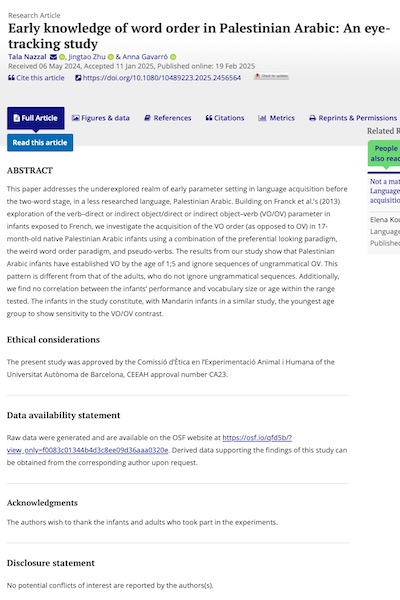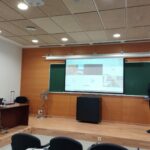21 gener, 2025
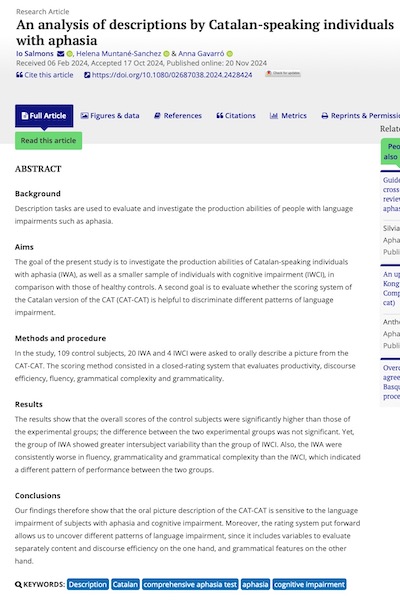
Autors:
Salmons, Muntané-Sanchez, & Gavarró
Títol:
An analysis of descriptions by Catalan-speaking individuals with aphasiaEditorial: Aphasiology
Data de publicació: 20-11-2024
Més informacióBackground
Description tasks are used to evaluate and investigate the production abilities of people with language impairments such as aphasia.
Aims
The goal of the present study is to investigate the production abilities of Catalan-speaking individuals with aphasia (IWA), as well as a smaller sample of individuals with cognitive impairment (IWCI), in comparison with those of healthy controls. A second goal is to evaluate whether the scoring system of the Catalan version of the CAT (CAT-CAT) is helpful to discriminate different patterns of language impairment.
Methods and procedure
In the study, 109 control subjects, 20 IWA and 4 IWCI were asked to orally describe a picture from the CAT-CAT. The scoring method consisted in a closed-rating system that evaluates productivity, discourse efficiency, fluency, grammatical complexity and grammaticality.
Results
The results show that the overall scores of the control subjects were significantly higher than those of the experimental groups; the difference between the two experimental groups was not significant. Yet, the group of IWA showed greater intersubject variability than the group of IWCI. Also, the IWA were consistently worse in fluency, grammaticality and grammatical complexity than the IWCI, which indicated a different pattern of performance between the two groups.
Conclusions
Our findings therefore show that the oral picture description of the CAT-CAT is sensitive to the language impairment of subjects with aphasia and cognitive impairment. Moreover, the rating system put forward allows us to uncover different patterns of language impairment, since it includes variables to evaluate separately content and discourse efficiency on the one hand, and grammatical features on the other hand.
28 abril, 2025
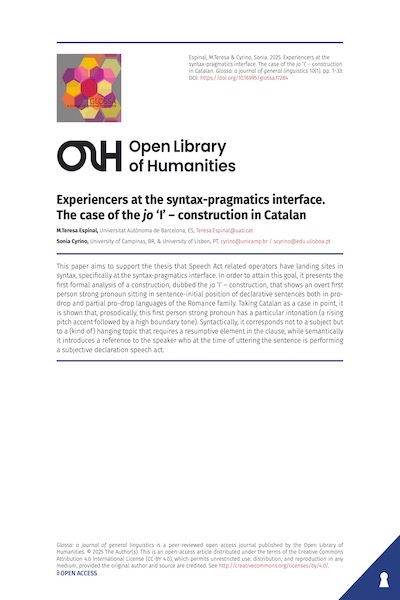
Autors:
Espinal & Cyrino
Títol:
Experiencers at the syntax-pragmatics interface. The case of the jo ‘I’ – construction in CatalanEditorial: Glossa: a journal of general linguistics
Data de publicació: 18-04-2025
Pàgines: 33 Més informació
Text completThis paper aims to support the thesis that Speech Act related operators have landing sites in syntax, specifically at the syntax-pragmatics interface. In order to attain this goal, it presents the first formal analysis of a construction, dubbed the jo ‘I’ – construction, that shows an overt first person strong pronoun sitting in sentence-initial position of declarative sentences both in pro-drop and partial pro-drop languages of the Romance family. Taking Catalan as a case in point, it is shown that, prosodically, this first person strong pronoun has a particular intonation (a rising pitch accent followed by a high boundary tone). Syntactically, it corresponds not to a subject but to a (kind of) hanging topic that requires a resumptive element in the clause, while semantically it introduces a reference to the speaker who at the time of uttering the sentence is performing a subjective declaration speech act.
26 setembre, 2025
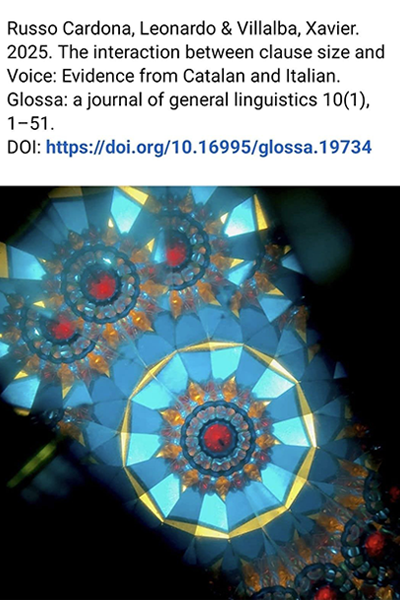
Autors:
Russo Cardona, L. & Villalba, X.
Títol:
The interaction between clause size and Voice: Evidence from Catalan and ItalianEditorial: Glossa: a journal of general linguistics 10(1)
Data de publicació: 18 de setembre de 2025
Més informació
Text completWe argue that in certain reduced embedded clauses Voice behaves differently from most other contexts, on the basis of tough-constructions (TCs) and modal passives (MPs) in Catalan and Italian. These constructions involve an A-dependency targeting only internal arguments of morphologically active transitive infinitives (unlike control, raising, and restructuring dependencies) because they involve a C/I-less VoiceP complement with a defective Voice layer (no accusative, no passive morphology, passive-like implicit agent). Thanks to the existence of a resumptive variant of TCs/MPs in Catalan, we propose a way to derive the distribution of defective Voice, which must be directly selected by a suitable lexical category, with regard to active/passive Voice, which must be directly selected by a functional head (at least in the languages at issue). Our findings bear on the broader theoretical debates about the typologies of Voice, clausal complements, and on the syntactic correlates of clause size.


